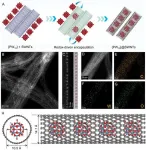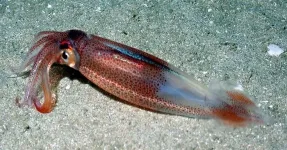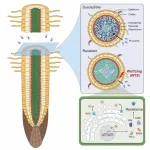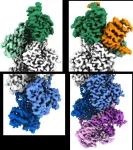(Press-News.org) A study of the DNA of more than 55,000 people worldwide has shed light on how we maintain healthy blood sugar levels after we have eaten, with implications for our understanding of how the process goes wrong in type 2 diabetes.
The findings, published today in Nature Genetics, could help inform future treatments of type 2 diabetes, which affects around 4 million people in the UK and over 460 million people worldwide.
Several factors contribute to an increased risk of type 2 diabetes, such as older age, being overweight or having obesity, physical inactivity, and genetic predisposition. If untreated, type 2 diabetes can lead to complications, including eye and foot problems, nerve damage, and increased risk of heart attack and stroke.
A key player in the development of the condition is insulin, a hormone that regulates blood sugar – glucose – levels. People who have type 2 diabetes are unable to correctly regulate their glucose levels, either because they don’t secrete enough insulin when glucose levels increase, for example after eating a meal, or because their cells are less sensitive to insulin, a phenomenon known as ‘insulin resistance’.
Most studies to date of insulin resistance have focused on the fasting state – that is, several hours after a meal – when insulin is largely acting on the liver. But we spend most of our time in the fed state, when insulin acts on our muscle and fat tissues.
It’s thought that the molecular mechanisms underlying insulin resistance after a so-called ‘glucose challenge’ – a sugary drink, or a meal, for example – play a key role in the development of type 2 diabetes. Yet these mechanisms are poorly-understood.
Professor Sir Stephen O’Rahilly, Co-Director of the Wellcome-MRC Institute of Metabolic Science at the University of Cambridge, said: “We know there are some people with specific rare genetic disorders in whom insulin works completely normally in the fasting state, where it’s acting mostly on the liver, but very poorly after a meal, when it’s acting mostly on muscle and fat. What has not been clear is whether this sort of problem occurs more commonly in the wider population, and whether it’s relevant to the risk of getting type 2 diabetes.”
To examine these mechanisms, an international team of scientists used genetic data from 28 studies, encompassing more than 55,000 participants (none of whom had type 2 diabetes), to look for key genetic variants that influenced insulin levels measured two hours after a sugary drink.
The team identified new 10 loci – regions of the genome – associated with insulin resistance after the sugary drink. Eight of these regions were also shared with a higher risk of type 2 diabetes, highlighting their importance.
One of these newly-identified loci was located within the gene that codes for GLUT4, the critical protein responsible for taking up glucose from the blood into cells after eating. This locus was associated with a reduced amount of GLUT4 in muscle tissue.
To look for additional genes that may play a role in glucose regulation, the researchers turned to cell lines taken from mice to study specific genes in and around these loci. This led to the discovery of 14 genes that played a significant role in GLUT 4 trafficking and glucose uptake – with nine of these never previously linked to insulin regulation.
Further experiments showed that these genes influenced how much GLUT4 was found on the surface of the cells, likely by altering the ability of the protein to move from inside the cell to its surface. The less GLUT4 that makes its way to the surface of the cell, the poorer the cell’s ability to remove glucose from the blood.
Dr Alice Williamson, who carried out the work while a PhD student at the Wellcome-MRC Institute of Metabolic Science, said: “What’s exciting about this is that it shows how we can go from large scale genetic studies to understanding fundamental mechanisms of how our bodies work – and in particular how, when these mechanisms go wrong, they can lead to common diseases such as type 2 diabetes.”
Given that problems regulating blood glucose after a meal can be an early sign of increased type 2 diabetes risk, the researchers are hopeful that the discovery of the mechanisms involved could lead to new treatments in future.
Professor Claudia Langenberg, Director of the Precision Healthcare University Research Institute (PHURI) at Queen Mary University of London and Professor of Computational Medicine at the Berlin Institute of Health, Germany, said: “Our findings open up a potential new avenue for the development of treatments to stop the development of type 2 diabetes. It also shows how genetic studies of dynamic challenge tests can provide important insights that would otherwise remain hidden.”
The research was supported by Wellcome, the Medical Research Council and the National Institute for Health and Care Research.
Reference
Williamson, A et al. Genome-wide association study and functional characterisation identifies candidate genes for insulin-stimulated glucose uptake. Nat Gen; 8 June 2023; DOI: 10.1038/s41588-023-01408-9
END
DNA discovery highlights how we maintain healthy blood sugar levels after meals
2023-06-08
ELSE PRESS RELEASES FROM THIS DATE:
Confinement effects of carbon nanotubes on polyoxometalate clusters enhance electrochemical energy storage
2023-06-08
Carbon nanotubes (CNTs) are considered ideal electrochemical energy storage materials due to their high electrical conductivity, large theoretical surface area, and good chemical stability.
However, CNTs tend to aggregate due to strong van der Waals forces, which reduces their electrochemically active area. This problem is even worse for single-walled carbon nanotubes (SWNTs) due to their high length-to-diameter ratio.
Recently, a joint research team led by Dr. WANG Xiao from the Shenzhen Institute of Advanced Technology (SIAT) of the Chinese ...
When water temperatures change, the molecular motors of cephalopods do too
2023-06-08
Cephalopods are a large family of marine animals that includes octopuses, cuttlefish and squid. They live in every ocean, from warm, shallow tropical waters to near-freezing, abyssal depths. More remarkably, report two scientists at University of California San Diego in a new study, at least some cephalopods possess the ability to recode protein motors within cells to adapt “on the fly” to different water temperatures.
Writing in the June 8, 2023 edition of Cell, first author Kavita J. Rangan, ...
A potential milestone in cancer therapy
2023-06-08
Prostate cancer is the most common non-skin cancer in men worldwide. According to international estimates about one in six men will get prostate cancer during their lifetime and worldwide, over 375’000 patients will die from it each year. Tumor resistance to current therapies plays an essential role in this and new approaches are therefore urgently needed. Now an international research team from the University of Bern, Inselspital Bern and the University of Connecticut (USA) has identified a previously unknown weak spot in prostate cancer ...
Comparing doctors to peers doesn’t make them hate their jobs and may improve quality of care, new USC Schaeffer study finds
2023-06-08
June 8, 2023 — Showing people how their behavior compares to their peers is a commonly used method to improve behavior. But in the wake of a global pandemic that exacerbated health care providers’ job dissatisfaction and burnout, questions remain about the potentially negative effects of peer comparison on the well-being of clinicians.
A new study from the USC Schaeffer Center for Health Policy & Economics reveals fresh insights into the relationship between peer comparison and job satisfaction among clinicians. Published in JAMA Network Open, the study challenges prior findings that such feedback increases job dissatisfaction and burnout.
Researchers ...
Scientists discover how plants fight major root disease
2023-06-08
Researchers led by CHEN Yuhang and ZHOU Jianmin from the Institute of Genetics and Developmental Biology of the Chinese Academy of Sciences have shown how plants resist clubroot, a major root disease that threatens the productivity of Brassica crops such as rape.
The study, which uncovers novel mechanisms underlying plant immunity and promises a new avenue for crop breeding, was published in Cell.
Clubroot, a soil-borne disease, is the most devastating disease of Brassica crops. In China, approximately 3.2–4 million hm2 of agricultural land is affected by clubroot each year, resulting in a 20%–30% yield ...
The IL-17 protein plays a key role in skin ageing
2023-06-08
A team of researchers from IRB Barcelona and CNAG identifies the IL-17 protein as a determining factor in skin ageing.
Blocking the function of IL-17 reduces the pro-inflammatory state and delays the appearance of age-related features in the skin.
Published in the journal Nature Aging, the work opens up new perspectives in the development of therapies to improve skin ageing health.
A team of scientists from the Institute for Research in Biomedicine (IRB Barcelona) in collaboration with the National ...
University of Cincinnati study examines role of metabolites in disease treatment
2023-06-08
Each year, about 200,000 people in the United States are diagnosed with a bulge in the lower part of the aorta, the main artery in the body, called an abdominal aortic aneurysm (AAA).
New research from the University of Cincinnati examines the role a particular metabolite plays in the development of AAA and could lead to the first treatment of the condition.
The research was published in the journal Circulation.
“We started the study by examining whether AAA patients themselves had an increase in trimethylamine N-oxide (TMAO). We examined an American and Swedish ...
Study unravels the mysteries of actin filament polarity
2023-06-08
Actin filaments — protein structures critical to living movement from single cells to animals — have long been known to have polarity associated with their physical characteristics, with growing “barbed” and shrinking “pointed” ends. The ends of the filament are also different in the way they interact with other proteins in cells. However, the mechanism that determines these differences has never been entirely clear to scientists. Now, researchers from the Perelman School of Medicine at the University of Pennsylvania have revealed key atomic structures of ...
Colorful foods improve athletes’ vision
2023-06-08
Nutrition is an important part of any top athlete’s training program. And now, a new study by researchers from the University of Georgia proposes that supplementing the diet of athletes with colorful fruits and vegetables could improve their visual range.
The paper, which was published in Exercise and Sport Sciences Reviews, examines how a group of plant compounds that build up in the retina, known as macular pigments, work to improve eye health and functional vision.
Previous studies done by UGA researchers Billy R. Hammond and ...
Research puts lens on a new vision for land use decision making
2023-06-08
A new framework for making better and more transparent decisions about the use of our land could help to balance society’s demands upon it with protecting and enhancing the environment.
Researchers led by the University of Leicester have proposed a framework for decisions on land use, from nationwide policymaking to building happening at street level, that would involve the most representative range of stakeholders, from those with financial interests in the land to the local communities who use it and more besides.
Now published in the journal People and Nature, it encourages decisionmakers ...




